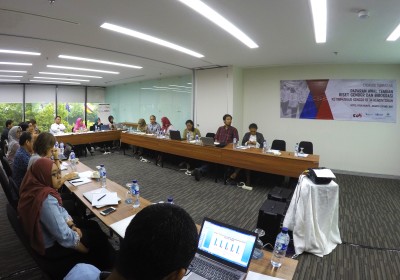Gender Inequality in the National Ministerial Bureaucracy
August 07, 2017
Dok.: Cakra Wikara Indonesia (CWI)
The number of female civil servants in the high ranked positions within the 34 ministries is very low. Until 2016, women only accounted for less than 26% of all civil servants appointed to the first to fourth echelon levels. The general pattern at the national level bureaucracy shows a diminishing number of women, or a bottleneck, in the promotion process from lower to higher echelons. This occurrence is especially noteworthy during the promotion from second to first echelons, the highest ranked position in the structure of bureaucracy.
These are some of the findings from a research on “Examining Gender Inequality in Bureaucracy – Preliminary Study of 34 Ministries in 2017” conducted by Cakra Wikara Indonesia (CWI). Anna Margret, chairwoman of CWI, presented these findings during a discussion with representatives from the ministries and state institutions, non-governmental organizations and women activists held in May 29, 2017, as part of a series of events in the Road to the Indonesia Development Forum 2017.
The research on gender and bureaucracy commenced in March 2017 and is conducted with the support from Knowledge Sector Initiative (KSI) Indonesia. The research collected data of the total number of civil servants in 34 ministries in the period of 2014 – 2016, obtained from the State Civil Service Body (Badan Kepegawaian Negara / BKN). Furthermore, this research also analyzed the contents of policies on the personnel of civil service, from the national law on State Civic Apparatus of 2014 (UU Aparatur Sipil Negara Tahun 2014) to other related lower level regulations.
The table below shows segregated data of civil servants in 34 ministries in 2014 to 2016.
Composition of Echelon and non-Echelon Civil Servants in Ministries
2014-2016
|
Year |
% Non-echelon male civil servants | % Non-echelon female civil servants | % Echelon-level male civil servants | % Echelon-level female civil servants |
|---|---|---|---|---|
| 2014 | 61.66 | 38.34 | 77.41 | 22.59 |
| 2015 | 59.90 | 40.10 | 77.94 | 22.06 |
| 2016 | 59.44 | 40.56 | 74.21 | 25.79 |
Source: BKN
The segregated data indicate that the number of female civil servants is relatively equal to that of male civil servants during recruitment process. However, Anna noted, in the higher echelon levels it becomes strikingly unequal as the number of high ranked female officials are much lower than the male officials.
Specifically, there are four patterns of gender distribution inequality. The first pattern is a gender-proportional distribution in recruitment which precedes a gender-proportional distribution after promotion process; second is gender proportional recruitment followed by unequal gender distribution after promotion procedure; third is a gender-unequal recruitment followed by gender proportional distribution after promotion process; the last one is unequal gender distribution in recruitment and promotion.
Anna further stated that in addition to the data of civil servants in the ministries, CWI also collected data of the number of graduates from Universitas Indonesia, based on their majors and academic achievements (cum laude). Data on fresh graduates of undergraduate students in 2013 and 2014 show that female graduates consistently outnumber their male counterparts by 30%. Female graduates made up around 58% (6,748) out of 11,681 fresh graduates. Women also accounted for 71% (1,626 out of 2,277) of cum laude graduates during 2013 to 2014. These data demonstrate that academically female graduates have more potential than male graduates do.
Ironically within the high-ranked positions in the ministries the number of women is diminishing, while according to CWI women representation in bureaucracy up to the highest structure is a necessity to empower female personnel to their maximum potential and open access for women to formulate and advocate strategic policies.
These preliminary findings were presented in a discussion mentioned above, designed to connect various elements of stakeholders in the effort to reform the bureaucracy. One of the participants emphasized that the Law on State Civic Apparatus of 2014 obligates the implementation of a merit-based system in the process of recruitment and promotion of civil servants. The system requires objectivity, transparency, and a competence-based promotion procedure, to create equal opportunity for all and eliminate practices of discrimination and nepotism in the process of recruitment and promotion. However, the merit-based system failed to address obstacles faced by women in recruitment and promotion: a dilemma of whether to prioritize family of career. Participants of the discussion revealed that a large number of female civil servants are hesitant to apply for promotion to a higher post because they prefer less demanding workload and responsibility to enable them in fulfilling their “domestic roles” as wives and mothers. The low number of women in the recruitment and promotion processes in the national ministries reflects a structural problem which requires a comprehensive coordination among various state institutions to address and alleviate gender inequality in bureaucracy.
Indonesia’s Research Institutions Supporting the Development of the Electric Vehicle Industry
Indonesian Muslim Fashion and Cosmetics IKMs Shine at Dubai World Expo 2020
Govt Steps Up UMKM Transformation Efforts in the Midst of Pandemic Slowdown
Govt Encourages Promotion of IKM Products in Digital Era
Government Begins Developing Maritime Training Center in Makassar
Tweets by IDDevForum
